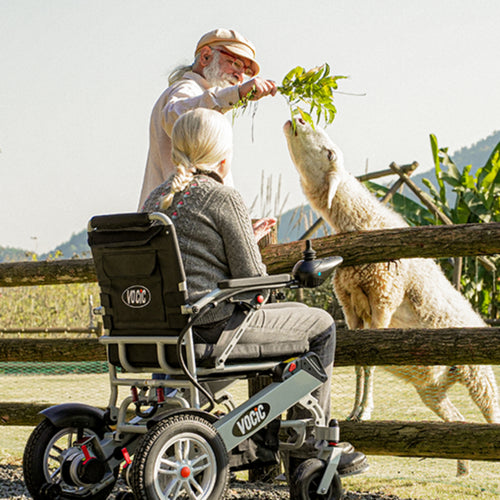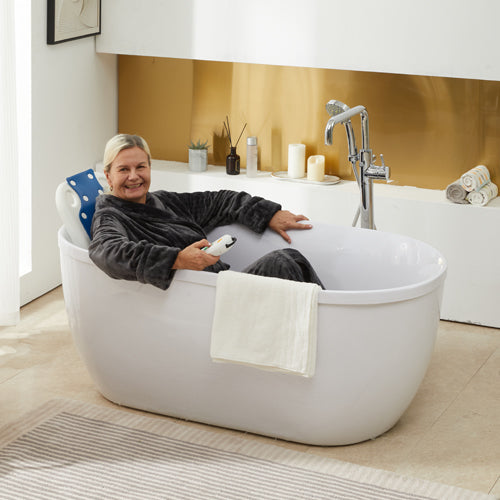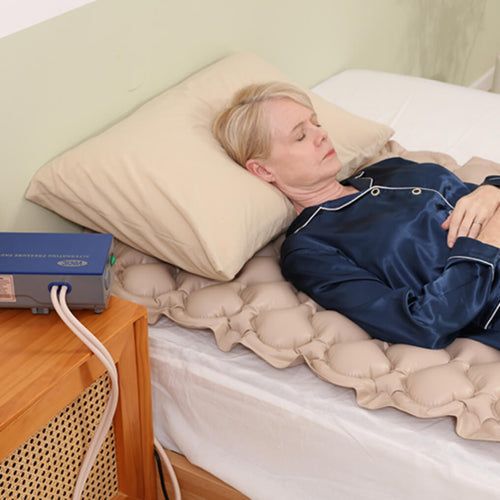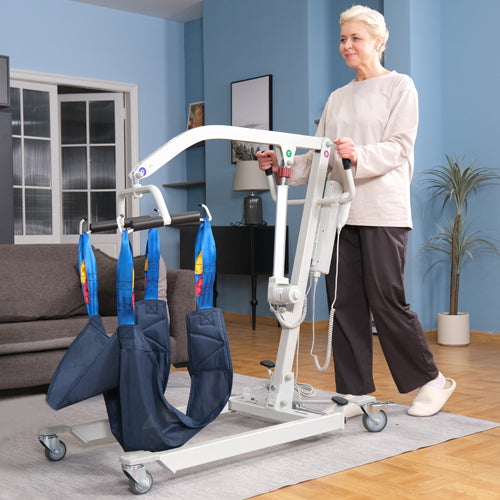Bedridden patients or someone who uses a wheelchair for long periods are more prone to developing bed sores. You can prevent them through the following seven methods: regular position changes, skin care, maintaining a cool and comfortable environment, enhancing bed comfort, choosing cool and breathable clothing for bedridden patients, creating an exercise plan, and ensuring proper nutrition and hydration. This article also explains what bed sores are, how they occur, and who is more likely to develop them.
What are Bed Sores in a Bedridden Patient?
Pressure sores, also known as bed sores, pressure ulcers, or decubitus ulcers, are areas of skin damage caused by insufficient blood flow. The affected skin may become necrotic and develop open ulcers. This reduced blood flow and subsequent damage result from pressure combined with friction, moisture, altered blood flow patterns, and skin stretching. Pressure sores typically occur over bony areas of the body, such as the hips, heels, sacrum (base of the spine), shoulder blades, back of the knees, sides of the knees, and the back of the head.
How Do Bed Sores Occur?
When you move infrequently, such as being confined to a bed or wheelchair, your body weight restricts blood flow to your arms, legs, neck, and back. Insufficient blood flow to the skin and underlying tissues can cause them to break down, leading to ulcers.
How to Diagnose Bed Sores?
Early symptoms of skin ulcers include redness, discoloration, or darkening of the skin (for African Americans, it may appear purple, blue, or shiny). The area may feel hard and warm to the touch.
- Stage 1: Skin is intact but shows redness or discoloration and may feel hard or warm. Pressing on it doesn’t cause it to lighten. Redness or color change doesn’t fade within 30 minutes of pressure removal.
- Stage 2: The outer layer of skin (epidermis) is damaged, forming a shallow open sore. The second layer (dermis) may also be affected. There may or may not be pus or fluid.
- Stage 3: The sore extends through the dermis into subcutaneous fat tissue. Bone, tendons, and muscles are not visible. Watch for signs of infection (red edges, pus, odor, fever, green drainage) and possible necrosis (black, dead tissue).
- Stage 4: The sore extends to muscle and possibly bone, with significant necrotic tissue and drainage. High risk of infection.
Who is Prone to Have Bed Sores?
People who are bedridden or use a wheelchair for extended periods are most likely to develop bed sores. The following factors also increase the risk:
- Weight loss—reducing fat over bony areas
- Sliding down from a bed or chair
- Friction against rough surfaces
- Dehydration
- Moist skin—from sweating or incontinence
- Thin, dry, or fragile skin
- Previous or existing pressure sores
- Age over 70
- Malnutrition or poor diet
- Anemia
- Chronic illnesses, such as diabetes
- ...
7 Tips on Prevent Bed Sores on a Bedridden Patients
1. Regular Position Changes
- Change positions regularly: If you are bedridden patients, change your sleeping position approximately every 2 hours. If you are in a wheelchair, change your position every 10 to 15 minutes. If you can't do it by yourself, ask someone to help you. Some electric transfer hoyer lifts can lift patients quickly and effortlessly.
- Place a pillow between your legs: If you are lying on your side, place a pillow between your legs. Slightly elevate your heels off the mattress by placing a pad or foam underneath your lower legs.
2. Skin Care
- Regularly check the skin: Examine the patient's skin daily, especially over bony areas, for early signs of pressure sores such as redness, discoloration, or hardening.
- Keep the skin dry: Frequently check the patient's skin, especially in moist areas like the buttocks, lower back, and groin. If you notice sweating or incontinence, clean the area immediately and change to clean sheets or clothing. For those prone to incontinence, incontinence underpads can be used for easy replacement.
- Wash with warm water: Clean soiled areas with warm (not hot) water and soap. Moisturize dry skin. It's also important to keep the skin warm and dry, as excessive moisture can increase the risk of skin infections.
- Maintain proper humidity: Apply moisturizing lotion to the skin to keep it adequately hydrated, preventing dryness and cracking.
- Use talcum powder: Depending on the situation, apply a moderate amount of talcum powder to areas prone to sweating to help absorb moisture and keep the skin dry. Avoid excessive use.

3. Maintain a Cool and Comfortable Environment
- Adjust room temperature: Keep the room temperature within a comfortable range (around 68-75°F). Use air conditioning or fans to help circulate air and lower the room temperature.
- Ventilate regularly: Open windows at regular intervals each day to ensure fresh air circulation in the room, but avoid direct drafts on the patient, especially if they are weak.
4. Enhance Bed Comfort
- Improve mattress comfort: Some air mattresses for bed sores offer various pressure-relief adjustments that effectively prevent and reduce pressure sores in long-term bedridden patients.
- Choose appropriate bedding: Select breathable mattresses and pillows. Using mattresses and pillows made from breathable materials like memory foam or latex helps with heat dissipation and maintains comfort.
- Regularly change bedding: To avoid moisture and bacterial growth, keep the sheets dry and clean, especially when sweating occurs. Changing bedding can be difficult for one person, but using a rotating bed can make it much easier.

5. Choose Cool and Breathable Clothing for Bedridden Patients
- Select loose, breathable clothing: Choose loose-fitting, breathable cotton or linen clothing for the patient. Avoid tight or non-breathable clothes.
- Change wet clothes promptly: If the patient sweats a lot, change their wet clothes promptly to keep their body dry.
6. Tips for Exercises for Bedridden Patients
- Personalized plan: Develop a personalized exercise plan for bedridden patients based on the patient's specific condition and abilities, and consult a doctor or physical therapist for advice before implementation.
- Professional supervision: Professional caregivers can guide the patient and assist family members in safely transferring the patient. For those caring for a patient alone, consider using an electric patient lift for home use.
- Gradual progression: Start with a moderate amount of exercise and gradually increase the intensity and duration to avoid excessive fatigue.
- Safety first: Ensure a caregiver is present during exercise to prevent falls or injuries.
7. Nutrition and Hydration
- Consume a balanced diet: Ensure an appropriate intake of protein, carbohydrates, fats, vitamins, and minerals to maintain a balanced diet.
- Stay hydrated: Make sure the patient drinks enough fluids to prevent dehydration. Offer cold water, juice, or electrolyte drinks, but avoid ice-cold beverages to prevent stomach discomfort.









